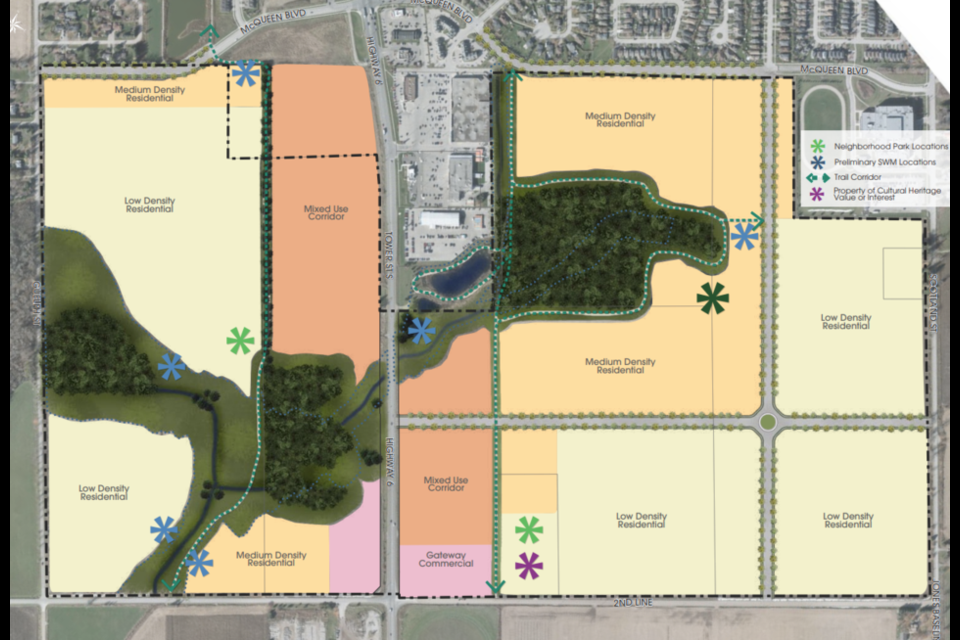FERGUS ‒ While many residents understand why additional urban development is necessary for Centre Wellington, they're asking their town to set an example for other municipalities to ensure the happiness and safety of everyone: present and future.
Attending a public meeting Wednesday evening, several residents shared their thoughts about a proposed amendment for the South Fergus Secondary Plan, a set of long-term guidelines for future development in the south end of Fergus, which included traffic mitigation measures, preserving heritage and prioritizing sustainable development.
Registered delegate and Fergus resident, Donnie Poirier, said he’s concerned about increasing traffic on Millburn Boulevard, asking for an approximate timeline for the project.
Dave Aston, from MHBC Planning Consultants, said construction could range anywhere from three to 10 years.
“Nobody that lives behind McQueen will ever be able to enjoy their backyard,” said Poirier. “People living on Millburn are already pissed about the traffic that's on their street and now this is going to flow over more onto McQueen.”
A farmer who lives on the south side of Second Line, Cindy Lindsay, shared Poirier’s concerns about traffic, explaining the challenges it poses while operating heavy farm machinery on the road.
“We have experienced several near misses as people tried to pass or speed even though the signs while moving from field to field or to the barn with our equipment,” said Lindsay. “This subdivision I think may very well become a bedroom community and traffic flow really needs to be considered quite seriously.”
Mayor Shawn Watters said he’s received several calls about traffic and agreed there is an opportunity for calming measures in the secondary plan.
“I understand everyone's in a hurry, but you'll still get to your place,” said Watters. “It may take a second or two, but it could save a life.”
Lindsay also asked that developers ensure any new developments would take their agricultural neighbours into account.
“While many love the idea of moving to a rural community, they may not understand or appreciate the nuances of living alongside an active farm operation, especially on a hot humid day,” said Lindsay. “Urban development is inevitable, I know that. But we can do it right.”
Agreeing with Lindsay, Poirier asked that developers make good on their commitment to “tasteful” development.
“Fergus is a gorgeous town,” said Poirier. “And when you put up subdivisions that are cheap and look like garbage, it takes away from the esthetics.”
Coun. Jennifer Adams asked that the plan consider what visitors see when they drive into town, advocating for a welcoming sign or manicured entrance-way of sorts.
“No offence to Cambridge, but I would hate for (the entrance to Fergus) to be like Hespeler Road,” said Adams. “We talk about heritage a lot and how important that is to us. But I think what we build today is our heritage of tomorrow.”
Lindsay took that a step further by asking developers to consider setting an example for future developments by incorporating sustainable elements like green roofs and solar panels.
“First impressions account for so much and we have a heritage that we are proud of,” said Lindsay. “Right now our entrance to Fergus does not reflect that heritage and so I think we need to bring that into consideration.”
Coun. Barb Lustgarten-Evoy emphasized the importance of encouraging green development within the municipality.
“I personally would like to hear that you actually are considering looking at options like green roofs, solar panels and (electric vehicle) charging stations as those items are very important,” said Evoy. “We support sustainability and recognize the challenges that climate change brings upon us.”
Taking notes during the meeting, Aston said the developers understand this is an opportunity to create something unique and special, sharing that some of Lindsay’s suggestions have already made it into their designs.
However, he said council needs to consider expanding the urban boundary to accommodate current and future employment and residential needs.
The proposed secondary plan would see nearly 7,000 people spread out across 3,100 units – low-density, medium density, and commercial residential apartments but will only generate close to 130 jobs.
“We think the best place for future business parks or employment land is not here,” said Aston. “It doesn't fit the character and the natural heritage that's in this area.”
The secondary plan will return to council for consideration later this year.
Isabel Buckmaster is the Local Journalism Initiative reporter for GuelphToday. LJI is a federally-funded program.



.png;w=120;h=80;mode=crop)